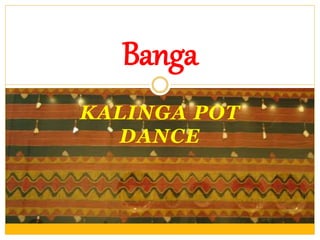
Banga (Philippine Folk Dance)
- 4. Introduction The Kalingas are the indigenous people in the province of Kalinga in the Gran Cordillera of northern Luzon. They are known for their good looks, colorful costumes and beautiful dances, making them the “peacocks of the north”
- 5. They are generally known to be tall, dark complexioned and lissome with high bridged noses. Physically, they are very sturdy and well built so that their ancient war-like characteristics make them more like fierce warriors.
- 6. The name Kalinga is believed to have come from Ibanag "Kalingaa" and Gaddang "Kalinga" which both mean headhunter , due to their practice of headhunting (kayaw) done during the tribal wars.
- 7. The budong is the most admirable and efficient Kalinga institution. It is a peace pact or treaty between two tribes, wherein the pagta (laws) on inter-tribal relations are made. The budong is also the Magna Carta of the Kalinga.
- 8. The gathering of tribes during the budong is a social occasion where music-making and dancing is held. One outstanding dance commonly performed is the Banga, a dance which illustrates the languid grace of a tribe.
- 9. Heavy clay pots, as many as seven or eight at a time, are balanced on the heads of maidens as they trudge to the beat of the gongs or wind chimes, displaying their stamina and strength as they portray their daily task of fetching water and balancing .
- 10. The dance is performed to the an ensemble of flat gongs called gangsa, which are beaten by the men who also participate in the dancing. The Banga is a contemporary performance of the Kalinga .
- 11. Etymology "Banga" literally means clay pots, thus the dance came to be known as the “clay pot dance”
- 12. Dance Properties Dance Culture – Highland Cordillera Place of Origin – Kalinga Ethnolinguistic Group – Kalinga (Northern and Southern) Classification - Festival
- 14. Props – Pile of clay pots (banga)of graduated sizes Mood – jovial Stance – erect Performers – all girls; male musicians Formation – circle, line, column
- 15. Music – Pattong played by an ensemble of 6 Gangsa (flat gong), each played by a musician who joins in the dance Time Signature – 4/4
- 17. Costume North Kalinga G: Guinamat (Kain) – knee-length rectangular wrap skirt of predominantly red hand-woven material, decorated with beads and sea shells.
- 18. In the past, Kalinga women were bare breasted and to simulate this, a skin-tone tight-fitting blouse is worn; or a yellow gold sleeveless blouse trimmed with the same designs as the skirt is worn.
- 19. Large agate, glass, stone and plastic beads predominantly colored red, black, white and yellow are strung to be worn as necklaces, armbands, earrings , choker and headband complete the female attire. Witawit – mother-of-pearl earrings
- 21. B: Baag – G-string of black cloth with ends accented with red, green, yellow and white checks, designs, fringes and pompoms Lamma – short open-fronted shirt with short sleeves
- 22. Strings of large beads are worn as chokers and necklaces Sipat – wristband made of bronze Red triangular headcloth accented with bunches of rooster tail feathers.
- 23. The lawi (rooster tail feather headdress) decorated with red hibiscus flowers is worn only by the minger (“hero”)
- 26. Southern Kalinga The Kalingas of the south do not wear upper garments but are heavily tattooed (in the past); instead they wear blankets (lilabey) like a shawl
- 28. Gestures and Steps Arms Arms sideward with flex-extend movements of the elbows like bird wings Arms in diagonal position Arms swinging at sides Hands on hips
- 29. Steps Light springy steps (leap bounce) Foot dragging (the other foot stamps ) Jumps
- 30. Dance Sequence (Suggested) The Kalingas do not have codified sequence of the dance nor specific duration and formations followed. The musicians make their own column, separate from the girls’ column
- 31. Figure 1 – Diagonal Entrance G: 8M – slow walk to formation, one step per measure; both hands holding pots on head 8M – springy walk (R and L per measure)
- 32. Figure 2 G: 16M – springy walk moving in circle CW B: One line behind G circle
- 33. Figure 3 G: 4M – feet in 2nd; spring both knees; lean sideward R; diagonal arms 4M – lean sideward L 8M – repeat B: line formation
- 34. Figure 4 G: 16M – springy walk in two column, moving in circle B: One column between G columns End – three columns
- 35. Figure 5 G: 4M – springy walk forward; arms diagonally upward 4M – springy walk backward 8M – repeat B: Feet in 2nd; springing on both knees
- 36. Figure 6 G: 8M – springy walk to partner’s place passing R to R 8M – repeat to return B: Move back to line at back of girls
- 37. Figure 7 G: 16M – springy walk moving in two circles, ending to one column; arms sideward B: stay at back line
- 38. Figure 8 G: 16M – springy walk; arms swinging at sides B: One line
- 39. Figure 9 B follows G 8M – spring walk moving in circle CW 8M – feet in 2nd; diagonal arms 16M – exit; B line leading
- 41. Source PFDS Sayaw Volume 7 pp. 16-18 Researcher – Jaime B. Pumakis
